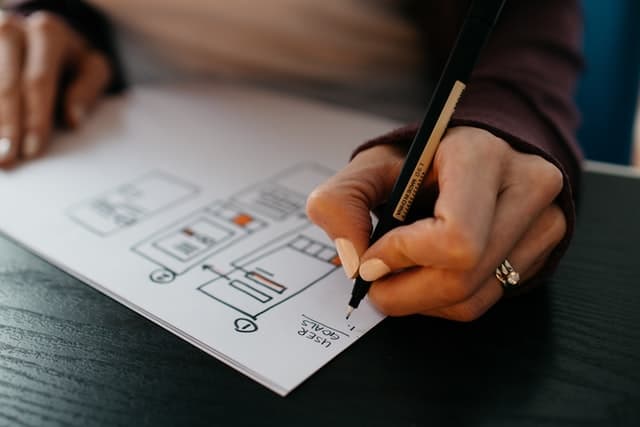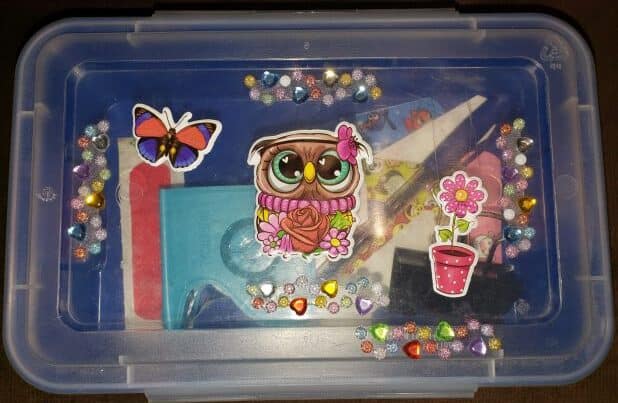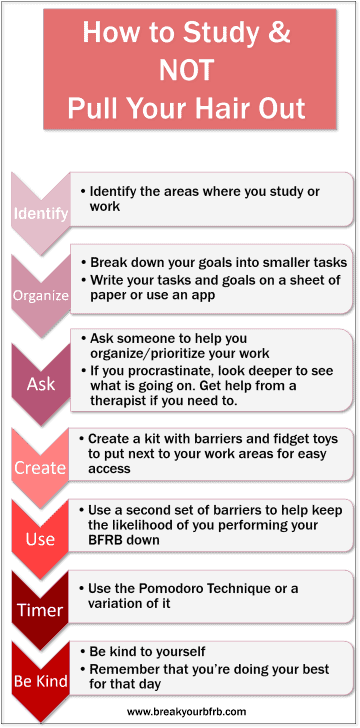7 Steps on How to Stop Pulling Your Hair While Studying
The worst period in my life for hair pulling was when I was studying to become a medical laboratory technician. For the greater part of those two years, I had pulled out most of my eyelashes. Sometimes my eyelids were bald. My eyebrows barely existed as well. The breaks in between semesters helped me to pull less because I wasn’t as stressed.
Back then, I somehow realized that I should try blocking my eyebrows and eyelashes. Vaseline worked, but only if I remembered to put it on.
I had a really hard time focusing. And between working and school, it’s no wonder! I look back and I give myself a lot of credit getting through all of that. I did the best that I could at that time. I didn’t have the tools back then that I do now.
I still have a hard time focusing. If I’m learning something new or try to work on something, I still get distracted. BUT, I’ve learned some new techniques that help me get through my tasks more efficiently and I want to share what I’ve learned with you.
Step 1: Identify where you study/work
Think about where you primarily study or work. I tend to study/work on the couch, kitchen table, or bed. That’s three places right there. And I’ve pulled at all three locations. So why are you pulling? In these situations, I pull because:
- I’m having a hard time focusing and I think that pulling is helping me to focus.
- I procrastinate and then I feel stressed.
- Pulling feels good and it’s comforting to me because I feel stressed.
- I feel overwhelmed because I have a lot of information to study or assignments to work on.
After a pulling session, I realized that I pulled out a significant amount of hair AND I didn’t even study. So I’m upset for both of those reasons. Then I have a hard time getting back to my task. And I need to do my task because it’s required. I try and sit down another time, but it happens all over again. It really is a vicious cycle.
So what can you do….
.
Step 2: Organize: Break down your tasks into smaller goals
As soon as you get an assignment, see if you can break it down into smaller tasks. Try to be realistic as well. If you do your best when you read a few pages at a time, don’t put a goal down for 20. It’s okay if you don’t know and you need to adjust.
I recommend writing the tasks down on a sheet of paper and putting it in an area where you know you’ll see them. I personally tend to be an out-of-sight, out-of-mind person. So having something visual helps me. You could put it on the refrigerator, a bulletin board, by your desk, etc.
If you prefer using technology, that’s perfectly fine too. You could write things down in a note app or Google spreadsheets. There are also different planner apps, such as My Daily Planner, Planner Pro, and more.
If you have a hard time getting started, you can always tell yourself, “I’ll just read one small paragraph, or a couple of paragraphs.” Normally when you get started, you can create some more momentum to keep going. You also have the choice to stop after those paragraphs.
The point here is…if you pull or pick when stressed and overwhelmed, this can help to lighten the load. Getting organized can take some of the pressure off. So perhaps you still feel like pulling or picking, but the urge to pull might not be as great as when you have a ton of work to do.
If you still find yourself procrastinating, not focusing, or feeling overwhelmed, don’t be afraid to ask for help. Which leads me to my next point.

Step 3: Ask for Help
For this part, I want to talk about two things: asking for help related to your assignments and asking for help relating to your beliefs.
- If you are completely stressed out or feeling overwhelmed, ask a family member or friend for help. Help can be different from person to person. Perhaps you have an exam coming up. You could ask someone to sit with you and help you organize tasks. If you’ve made flashcards, ask someone to flip the cards.
- If you’re having problems with organizing and are still having issues even getting started, you may need to look deeper. Why are you procrastinating? Do you normally have perfectionistic tendencies?
I know I did. This was a problem for me and still can be a problem now. I can get pretty perfectionistic at times. I would be afraid of failing and I wouldn’t see the point in doing things. But…all of those things lead to my ultimate goals. I needed to do my assignments or study for an exam.
What is deep down causing your perfectionism/anxiety/fear of failing/etc.? This may be something to explore with a therapist or it could be something you do on your own. If you’re reading this now and don’t have time because you have deadlines coming up, you may not have the time or energy to think about this right now. And that’s okay. Do what you need to do.
At some point, it might be a good idea to look into what’s going on. It’s exhausting to try to cram things in under pressure and on top of that, having to deal with hair pulling, skin picking, or other BFRBs.
I had a lot of stress during those two years. I was working full time and going to school almost full time. It’s exhausting and if I could go back and change how I did that, I would.
Step 4: Create a Kit
This is a part that I really enjoy. We’re going to make a simple BFRB kit. It will require some experimentation and tweaking over time, but you can get creative and I love that!
In Step 1, you identified the places where you primarily study/work. Now we are going to put a kit in each of those areas. A kit can consist of a box, a pouch, or you could use a bowl/mug/cup that you don’t normally use. What you are doing here, is storing your items for easy access. What does a kit include?
- Fidget toys. This is to keep your hands busy so they don’t wander to areas to pick or pull.
- Barriers for your fingers. These can include band-aids, medical tape, tape, finger cots, guitar finger covers, gloves(whatever types of gloves you prefer), etc.
- Any inspirational notecards that you would like to write or nice pictures. It can help bring your mood up when you’re stressed and feeling down.
This particular kit is smaller because we are strategically placing it next to our study/work areas. We’ll go over how to make a bigger kit where we can store more things in a different article. Feel free to decorate your container!

Step 5: Use a second set of blockers/barriers
The more barriers you use, the better off you’ll be. For example, if you’re wearing band-aids and you take them off, having Vaseline on the eyebrows could prevent you from pulling. Here are some more examples:
- Head: wear a headband, headscarf, beanie, wet the hair down, braid the hair, pull or pin the hair back.
- Eyebrows: use Vaseline or some kind of oil, such as castor oil, to coat the eyebrows. Sometimes I have a prickly eyebrow hair that drives me insane. I’ll use a Q-tip to coat my eyebrows with either Vaseline or oil. By using the Q-tip, I’m not directly touching my eyebrows. Sometimes, I want to pull that prickly hair out if I touch it.
- Eyelashes: wear glasses or glasses without any kind of prescription, use Vaseline or an oil such as castor oil( just be careful to not get anything into your eyes). *Test castor oil on your skin before applying it to your face. Read this article for more information.
- Nose: I’m having a hard time thinking of what you could use to block the nose. There’s always a mask, but I’m not sure if that’s something you’d want to do. I would keep tissues nearby so you can blow your nose or a saline spray so you may be less inclined to pick.
- Biting/chewing the tongue or cheeks: try Chewlry(chewable jewelry), gum, suck on ice or a popsicle, use a mouthguard. There are over-the-counter mouthguards or you could be fitted by a dentist.
- Biting/picking/chewing lips: use a lip balm or Vaseline several times a day and before going to bed. Here are some tips from the AAD (American Academy of Dermatology Association).
- Beard: use beard oil or beard balm, or wet the beard.
- Picking the face in general: potentially use hydrocolloid patches (check out this article from healthline.com).
- Arms, legs, back, etc.: Wear tighter fitting clothing (not too tight) to make it harder to access. Depending on the climate, long sleeve shirts, pants, or leggings can block. Using healing ointments on already open wounds and bandages.
- Feet: use longer socks and/or wear shoes, tuck your pants into your socks.
These are some examples of the second set of barriers you could use while working/studying. This isn’t a complete list and maybe you’ll have a different idea!
Step 6: Use the Pomodoro Technique
What is the Pomodoro Technique?
The Pomodoro Technique was founded by Francesco Cirillo when he was a university student. The basic premise of the technique is:
- Have your tasks ready
- Set a timer for 25 minutes
- When the timer goes off, mark that you completed one Pomodoro.
- Take a 5-minute break
- Start over again. After 4 Pomodoro’s (25 minute intervals of working and a 5-minute break in between) take a longer break of 20 or 30 minutes.
To be completely clear with all of you, I don’t follow this technique exactly. But it’s where I got the inspiration to help organize my time effectively. Once I get in the groove, I want to focus for a while and complete my task. I’ll study/work for about 45 minutes and then go take a break. I repeat that process a few times.
Whether you follow the technique exactly or make a variation of it for your own needs, this method can break up your time and your urges to pull. I still get urges and the tension to pull my hair. But when using the barriers and this time organization technique, I normally don’t pull. When I do get urges, that can signify that I need a break as well. I’ll get up, go walk around, make a cup of tea, step out on the balcony, etc. Then my urge to pull passes.
Step 7: Be Kind to Yourself
This tip is one of the most important. It can be hard to get through necessary tasks, especially when you have a BFRB. If you’re here reading this, you’re doing your best to improve yourself. Otherwise, you wouldn’t be reading this right now. It may be hard trying to get through your tasks. You may end up picking or pulling. You did the best that you could for that day. There’s a quote that I read recently on social media:
“Someone once told me something along the lines of ‘You’ve gotta do your best every day, but remember that your best is going to look different every day.’ And it’s one of the most healing things I’ve heard to this day bc it reminds me not to put too much pressure on myself.” -Javia Alissa @jaealissa_
This quote really reasonates with me. Since I’ve read it, I think about it almost every day actually. It reminds me to be gentle with myself and speak to myself kindly.
I’ve had days where I forgot to put my barriers on or I didn’t take a break when I really should have. And I pulled. I used to get upset when that happened. Over time, I’ve come to accept that there will be times when I pull and I am no longer hard on myself. I just try to learn from what happened and move on.
If you do end up pulling or picking and need to cry or are upset, that’s okay. Let it out. Take a break, call a friend, or go for a walk. When you have time and are calm, see what you can do to adjust your plan. Maybe use a different barrier or adjust your study/work times. You’ve got this!
Final Thoughts
These are the steps that I use to combat pulling my hair or picking my skin while studying/working. If you’re reading this and don’t have time to follow all of the steps right now, I recommend:
- Quickly organizing what you need to do.
- Using at least one blocker and have some kind of fidget toy to keep your hands busy. If you don’t have a fidget toy, I play with office supplies, such as pens or binder clips.
- Use the Pomodoro technique or a variation of it to help organize your time, and give yourself breaks so you don’t perform your BFRB.
When you have time, I recommend going through the steps and preparing in advance so you don’t really need to think ahead-you’re already prepared. For example, making sure you have a small kit nearby your study/work area.
This doesn’t resolve hair pulling. Directly dealing with the BFRB, whether it be self-help or with a therapist is best. But I understand how hard it can be to get through tasks that need to be completed and you don’t have time to dive deeper into why you’re pulling. I hope this can help you or spark some ideas in your head so you can get through tough study/work times.
Let me know what you think! Leave a comment 😀

7 Steps on How to Stop Pulling Your Hair While Studying
*All content and information on this website including our programs, products and/or services is for informational and educational purposes only, does not constitute medical, psychological or health advice of any kind and we do not warrant that the information presented herein is free of any errors or omissions. We are not providing medical, health care, nutrition therapy or coaching services to diagnose, treat, prevent or cure any kind of physical ailment, mental or medical condition.
Although we strive to provide accurate general information, the information presented here is not a substitute for any kind of professional advice, and you should not rely solely on this information. Always consult a professional in the medical and health area for your particular needs and circumstances prior to making any medical or health related decisions. For your health related questions, please seek the advice of a licensed physician or any other qualified health care provider immediately.



